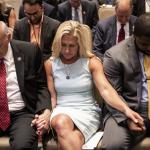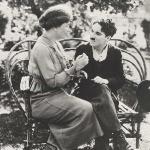By R. Drew Smith
There is a scripture verse that has become a tag line for the thriving praise and prosperity emphasis within American Christianity: “For I know the plans I have for you,” declares the Lord, “plans to prosper you and not to harm you, plans to give you hope and a future” (Jeremiah 29: 11, NIV). It should be noted that the popularity of this verse has coincided with a growth in the percentage of American households receiving $35,000 or more in household income. White households in this income range, for example, increased from 56 percent in 1975 to 66 percent in 2006, and black households increased from 43 percent to 47 percent. During that same period white median household income increased from $39,500 TO $50,500 and black median household income increased from $23,500 to $32,000. The social promise embodied in the Jeremiah verse no doubt interacts with the upward social trajectories of the more socially successful classes in mutually reinforcing ways.
This verse gets turned on its head in more than one way when it is considered alongside the tragic circumstances that unfolded recently in Ferguson, Missouri. The fatal confrontation between police officer Darren Wilson and an unarmed black teenager Michael Brown, and the ensuing confrontations between heavily armed law enforcement personnel and large numbers of persons protesting Brown’s killing have confirmed in very poignant and telling ways, a dangerous distance that has developed between younger generation, low-income urban blacks and key sectors presumably concerned with public well-being. Brown’s killing, and the very uneven and frequently cold public response to a large number of apparently unjustified police killings of black males, leaves many blacks feeling that to the extent there is some grander social design shaping their American social existence it seems intended more for their harm than their good.
This is made clear in a disproportionately punitive law enforcement approach to black youth, where black youth, representing 26% of juvenile arrests, comprise 44% of youth who are detained, 46% of youth judicially waived to criminal court, and 58% of youth admitted to state prisons (Center on Juvenile and Criminal Justice). In general, African American males are six times more likely than white males to be incarcerated (Pew Research Center), and the prison sentences black males receive are 20 percent longer than white men receive when charged with similar crimes (U.S. Sentencing Commission). And as revealed by the recent deaths of Brown, and also of Kajieme Powell in St. Louis, and Eric Garner in Staten Island, black men are far too likely to be subjected to disproportionate force by the police. This undoubtedly contributes to the staggering fact that two black men per week are killed by officers of the law. For many black males, therefore, justice seems neither blind nor balanced, and the police seem intent on neither serving nor protecting.
While there have been encouraging levels of outrage and sympathy expressed across the nation in response to Brown’s killing, there have been many others who have made it clear they feel little or no angst about a policeman gunning down an unarmed black teenager, (even on the heels of the killings of the unarmed Eric Garner and Trayvon Martin in the name of law enforcement). In the days since Brown’s shooting, rallies in support of justice for Brown (though marred by violence from a segment of the protesters) were responded to initially by a massive show of force by law enforcement personnel, and by high-profile derision from conservative commentators such as Bill O’Reilly who dismissed protestors’ calls for justice as insincere, one-sided, and less deserving of public attention than the looting and rioting associated with the protests.
The racial divide and the sympathy divide are also evident in the emergence of white counter-mobilizations and fund-raising in support of Officer Wilson (with moneys raised for Wilson now eclipsing those raised for the Michael Brown Memorial Fund). The divides are captured as well in data from a Pew Research Center poll in which only 25 percent of whites as compared with 54 percent of blacks indicated they were following the Ferguson story closely. Is there any wonder that young African Americans would in some instances resort to collective violence as they did in the aftermath of the Brown shooting (and in the aftermath of the 1992 acquittal of officers whose brutal beating of unarmed motorist Rodney King was caught on videotape). When obvious injustices go unpunished and community protestations are met with indifference, derisiveness, or repression, people understandably resort to less conventional means in order to be heard.
Although few, as yet, are privy to all the facts in the Brown shooting, it is distressing that in a nation that enshrines citizen rights and equal protection under the law there has not been a broader American willingness to concede the fact that African American males have too often been denied the expectation of fairness and mutual regard implied in constitutional conceptions of “the American public.” Too often, black males are not seen or treated as “America’s promise.” They are seen and treated as “America’s problem”—and the subtext to the “black-male-as-problem” trope (since its conceptual imposition during the slavery era) is that black males are violence-prone. But while violence within black communities clearly has reached alarming proportions, violence by “angry white males” in the form of mass-casualty violence directed at schools, shopping malls, sporting events, military bases, and government office buildings has also reached alarming proportions. Yet we do not see the same kind of “preemptive” police rousts, stops, searches, and killings of white males that have been so routinely visited upon black males. When white males act out, we look for underlying causes. When black males act out, we proceed reflexively and unswervingly to judgment and to calculations of the metrics of punishment. If Kajieme Powell had been a white male daring two white St. Louis policemen to shoot him, would they have been quite so quick to oblige? For the law enforcement sector to gain greater public trust within black communities it will have to systematically address the glaring racial disparities in the enforcement of the law.
However central the law enforcement sector is to the fatal confrontation in Ferguson and to similarly racially-charged confrontations elsewhere, public failings associated with other domains also contribute to black frustration, defiance, and disillusionment. Governmental leaders more concerned with supporting tax breaks for the wealthy than effective educational and job training opportunities for the poor abandon segments of the community most in need of their support. And while governmental inattention to the poor is a public failing, negative attention is as well—and the law enforcement sector has plenty of company in this regard. The media is quick to provide negative coverage of black males. Our schools are quick to expel black males. And the American public is quick to accept these various ill-treatments of black males as normative.
Culpability is widespread for the fatal confrontations in Ferguson and in other urban spaces. Addressing this crisis will require a national, cross-sector, and interracial pursuit of a more vitalized and robust conception of “public” that acknowledges as Martin Luther King, Jr. said: “We are caught in an inescapable network of mutu
ality, tied in a single garment of destiny. What affects one directly, affects all indirectly.” Creating social spaces capable of embodying this conception of public has proven extremely difficult, but America is blessed with a rich array of social and spiritual resources that can be deployed in this ongoing effort—including traditions of free speech, free-flowing information, and protected dissent that help bring social failings and shortcomings to light, and civic, religious, and constitutional principles that shape and insist upon democratic, humane, and just social practices. We must continue to pursue these richer conceptions of public within each of our communities, geographic contexts, and organizational frameworks. Failure to do so will undoubtedly reproduce the tragic clashes and confrontations suffered recently in Ferguson and in too many other contexts across this nation.
R. Drew Smith, PhD. is Professor of Urban Ministry at Pittsburgh Theological Seminary and Co-Convener of the Transatlantic Roundtable on Religion and Race















